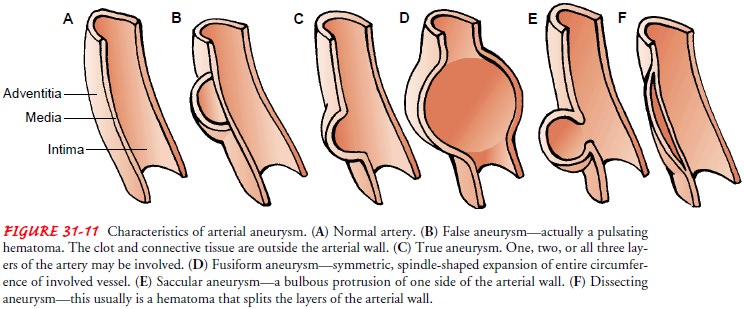Chapter: Medical Surgical Nursing: Vascular Disorders and Problems of Peripheral Circulation
Dissecting Aorta

DISSECTING
AORTA
Occasionally,
in an aorta diseased by arteriosclerosis, a tear de-velops in the intima or the
media degenerates, resulting in a dis-section (see Fig. 31-11).

Pathophysiology
Arterial
dissections (separations) are commonly associated with poorly controlled
hypertension; they are three times more com-mon in men than in women and occur
most commonly in the 50- to 70-year-old age group (Rutherford, 1999).
Dissection is caused by rupture in the intimal layer. A rupture may occur
through adventitia or into the lumen through the intima, allow-ing blood to
reenter the main channel and resulting in chronic dissection or occlusion of
branches of the aorta.
As the
separation progresses, the arteries branching from the in-volved area of the
aorta shear and occlude. The tear occurs most commonly in the region of the
aortic arch, with the highest mor-tality rate associated with ascending aortic
dissection. The dissec-tion of the aorta may progress backward in the direction
of the heart, obstructing the openings to the coronary arteries or produc-ing
hemopericardium (effusion of blood into the pericardial sac) or aortic
insufficiency, or it may extend in the opposite direction, causing occlusion of
the arteries supplying the gastrointestinal tract, kidneys, spinal cord, and
legs.
Clinical Manifestations
Onset
of symptoms is usually sudden. Severe and persistent pain, described as tearing
or ripping, may be reported. The pain is in the anterior chest or back and
extends to shoulders, epigastric area, or abdomen. Aortic dissection may be
mistaken for an acute myo-cardial infarction, which could confuse the clinical
picture and ini-tial treatment. Cardiovascular, neurologic, and
gastrointestinal symptoms are responsible for other clinical manifestations,
de-pending on the location and extent of the dissection. The patient may appear
pale. Sweating and tachycardia may be detected. Blood pressure may be elevated
or markedly different from one arm to the other if dissection involves the
orifice of the subcla-vian artery on one side. Because of the variable clinical
picture associated with this condition, early diagnosis is usually difficult.
Assessment and Diagnostic Findings
Arteriography,
CT, transesophageal echocardiography, duplex ultrasonography, and magnetic resonance
imaging aid in the diagnosis.
Medical Management
Medical
or surgical treatment of a dissecting aneurysm depends on the type of
dissection present and follows the general princi-ples outlined for the
treatment of thoracic aortic aneurysms.
Nursing Management
A
patient with a dissecting aorta requires the same nursing care as a patient
with an aortic aneurysm requiring surgical intervention, as described earlier.
Interventions described in the Plan of Nursing Care are also appropriate.
Related Topics